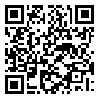Volume 15, Issue 1 (April 2017)
Nursing and Midwifery Journal 2017, 15(1): 10-18 |
Back to browse issues page
Download citation:
BibTeX | RIS | EndNote | Medlars | ProCite | Reference Manager | RefWorks
Send citation to:



BibTeX | RIS | EndNote | Medlars | ProCite | Reference Manager | RefWorks
Send citation to:
Moradi E, Didehban H. FACULTY MEMBERS DEVELOPMENT IN MEDICAL EDUCATION: PROGRAMS, INTERVENTIONS AND OUTCOMES. Nursing and Midwifery Journal 2017; 15 (1) :10-18
URL: http://unmf.umsu.ac.ir/article-1-3068-en.html
URL: http://unmf.umsu.ac.ir/article-1-3068-en.html
1- Instructor, Education Development Center (EDC), Urmia University of Medical Sciences, Urmia, Iran
2- MSc, PhD candidate in medical education, Department of Medical Education, Tehran University of Medical Sciences, Tehran, Iran. (Corresponding Author) ,razi.tums.ac.ir
2- MSc, PhD candidate in medical education, Department of Medical Education, Tehran University of Medical Sciences, Tehran, Iran. (Corresponding Author) ,
Abstract: (7302 Views)
Background and Aims: Faculty member’s development at present and with regard to recent developments in various fields of medical education, is very important. This issue is so important various programs have been conducted in different countries. In this review article we try to identify the various aspects of empower faculty members in medical education in Iran and worldwide.
Materials and Methods: In this review study, by using the key words of faculty member development, medical education, medical universities and their English equivalents, studies from 2000 to 2014 in the database, Scopus Google scholar, Pub med were searched. Finally, to analyze the different aspects of empowerment programs, related articles, studies and various aspects of the programs, were studied.
Results: According to results, entries were grouped into four categories: 1) analyze the content of faculty development programs, 2) educational methods used in faculty member development programs, 3) the type of interventions used in faculty member development programs, 4) faculty development outcomes.
Conclusions: Promoting empowerment programs in medical education, need to use a wide variety of content for implementation, qualitative and mixed methods studies and use of multiple and high level data sources. However, if we believe that faculty development programs, improves professional skills and qualifications of the faculty members, accordingly, using a systematic plan to evaluate the results of the program can be improved empowerment programs. As a result, faculty members and individuals involved in empowerment programs must continue to reflect the inherent weaknesses of traditional empowerment programs and at the same time, it should be noted that the faculty development is complex process and has intertwined structure.
Type of Study: Review article |
Subject:
Medical Education
Send email to the article author
| Rights and permissions | |
 |
This work is licensed under a Creative Commons Attribution-NonCommercial 4.0 International License. |






 gmail.com, unmf
gmail.com, unmf